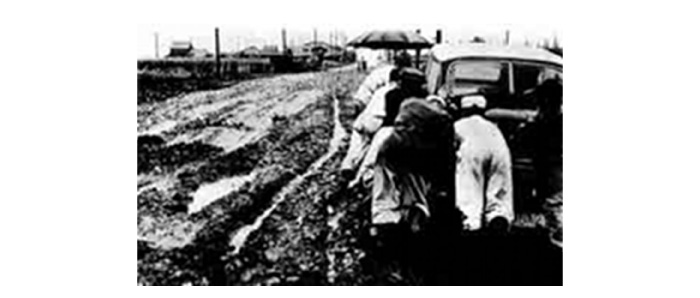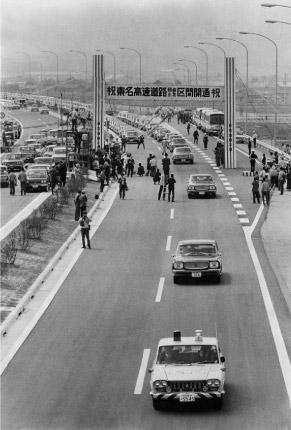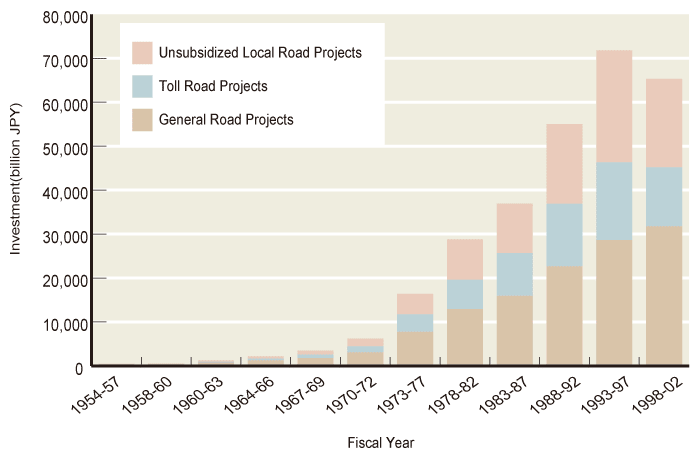History
3. Age of High Efficiency Networks
(from the 1950s ~ today)
1) Arrival of the Motorization Age
Automobiles proliferated quickly as the Japanese economy
recovered from defeat and the standard of living improved.
Only 130,000 vehicles were registered at the end of World
War II, but the number increased rapidly, reaching 500,000
vehicles by 1951, then doubling to one million in 1953, and
doubling again to two million in 1957. The Age of Motorization
had finally arrived in Japan.
However, the road system in Japan remained insufficient to
support the ongoing rapid motorization. Ralph J. Watkins,
an economist invited by the Japanese Government to
conduct research on the Meishin Expressway, wrote in his
1956 report, “The roads of Japan are incredibly bad. No
other industrial nation has so completely neglected its
highway system.”
Indeed, Japan’s road system in those days was truly terrible.
Only 23% of the first-class arterial national highway system
was paved. Only two-thirds of national Highway Route 1,
supposedly the major arterial highway connecting Tokyo
with Osaka, was paved. The Japanese Government at that
time accepted Mr. Watkins’ proposals and immediately put
them into practice. Thus, road improvement in Japan moved
into high gear, propelling the nation into the high economic
growth era of later years.
 The state of roads in the mid 1950s was "incredibly bad" as Watkins wrote in his report.
The state of roads in the mid 1950s was "incredibly bad" as Watkins wrote in his report.

TApril 1968 Vehicles running from Okazaki IC to Komaki IC after the opening ceremony of Tomei Expressway (Photo:Mainichi Shimbun)
2) The Five-Year Road Development Program, Toll Road System, and Tax Revenue System with Earmarks for Roads
Without a long history of horse-drawn carriages, the roads in
Japan were severely underdeveloped. What was worse, road
development was inevitably slow because the development
of railways was given priority over the development of roads.
Under these circumstances, the Five-Year Road Development
Program was launched so that road development could be
fully accelerated.
Since the public works budget, under the general revenue
scheme, was insufficient in meeting the ever-increasing road
traffic demand, two new financing systems were introduced:
the toll road system and the tax revenue system with
earmarks for roads. These systems allowed for a significant
number of road projects to be undertaken in a short period
of time.
The former “Act on Special Measures concerning Road
Construction and Improvement”, which was enacted in
1952, introduced the toll toad system and enabled the
national and municipal governments to borrow sufficient
funds to develop roads. After the new roads were complete,
the borrowed money would be repaid using the toll revenue
from the roads.
The toll road system was used primarily for national expressway
projects. In 1956, the Japan Highway Public Corporation
(JH) was founded, so that expressways would be
efficiently managed and financial resources from the private
sector could be widely utilized.
With its founding, toll road development was now led by JH
instead of the National Government. Although the mechanisms
of the toll road system are similar to that of current
PPP projects, the former included an ingenious system that
enabled them to carry out unprofitable road projects if the
road was recognized as necessary from an economic
vantage point. The National Government reduced the
business risk of unprofitable road projects by guaranteeing
the loan and by paying a fixed rate of interest. In addition,
the Government utilized the pool system, in which revenues
and expenditures were balanced throughout the integral
road network. This system enabled them to develop not only
profitable urban roads but also unprofitable regional roads
across the country.
In 1953, the “Act on State’s Tentative Financial Measures for
Road Construction Projects” was enacted and thus ushered
in a new tax revenue system with earmarks for roads. This
system, based on the “beneficiary-pays” principle,
earmarked the revenue from fuel tax and other
automobile-related taxes for road projects. This measure
secured stable financial resources for the long-term development
of roads, including the 1st Five-Year Road Development
Program and the subsequent 11 programs that
followed.
The toll road system and the tax revenue system with
earmarks for roads supported the development of the
nationwide road network for more than 50 years. During
those years, all major roads were paved and more than
10,000km of expressways were developed all across the
country.
However, there were increasing calls for a change in both of
the financial revenue systems since the road network in
Japan had reached an adequate level of development. There
were various critiques and opinions about road development,
including the belief that roads were developed
profligately and sometimes redundantly, spending a large
amount of both borrowed money and the national budget.
At the same time, the repayment and management costs
were not being sufficiently preserved due to the high-cost
structure of JH’s toll road system. As a result, JH was
privatized and reorganized into the Japan Expressway and
Debt Repayment Agency (JEDRA) and 6 other Expressway
Companies. The main purposes of this change were to
ensure the repayment of the massive road debt that had
reached 40 trillion yen, to streamline the administrative
authority, and to provide various services for road users by
utilizing experience from the private sector.
There was also increasing criticism of the tax revenue system
with earmarks for roads. Critics argued that fixed expenditures
from the abundant financial resources resulted in
unnecessary road development. In 2009, the tax revenue
system with earmarks for roads was abandoned and the
Government decided to pay for road expenditures using
funds from the general revenue.
 Note: 1) Reserve fund (¥150 billion) is included. 2) Reserve fund (¥100
billion) is included. 3) Reserve fund (¥500 billion) is included. 4)
Reserve fund ¥700 billion) is included. 5) Adjustment cost (¥1,300
billion) is included. 6) Adjustment cost (¥1,300 billion) is included.
7) Adjustment cost (¥1,400 billion) is included. 8) Adjustment cost
(¥5,000 billion) is included. 9) Reserve fund (¥11.2 billion for
Okinawa) is included in the total of the 6th plan.
Note: 1) Reserve fund (¥150 billion) is included. 2) Reserve fund (¥100
billion) is included. 3) Reserve fund (¥500 billion) is included. 4)
Reserve fund ¥700 billion) is included. 5) Adjustment cost (¥1,300
billion) is included. 6) Adjustment cost (¥1,300 billion) is included.
7) Adjustment cost (¥1,400 billion) is included. 8) Adjustment cost
(¥5,000 billion) is included. 9) Reserve fund (¥11.2 billion for
Okinawa) is included in the total of the 6th plan.
